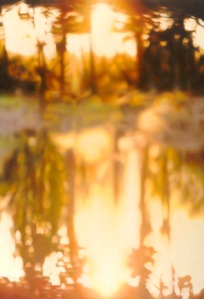This post comes to us from Sarah Solberg, Curatorial Intern
“Everything vanishes, falls apart doesn’t it? Nature is always the same but nothing in her that appears to us lasts. Our art must render the thrill of her permanence, along with her elements, the appearance of all her changes. It must give us a taste of her eternity.”
– Paul Cézanne
When viewing Jane Bunker’s work, you are given the opportunity to share in the way that she and many others experience the world around them. Bunker was diagnosed as a child with myopia, or (plainly) extreme nearsightedness. Although her vision has been corrected, it still deeply influences her work and the way that she sees her surroundings. Having personal experience with myopia, I can attest that she has captured the distorted world where I find myself every time that I remove my glasses. Sharing in her experience, I immediately connected with her work.
The show is aptly titled “Illumination,” because the subject of Jane’s work is light. While the paintings themselves appear vague, the way that she captures the light does not lack specificity. Thanks to Bunker’s precise use of color, we can recognize familiar scenes in blurred subjects. As evidenced in Reflection, her subtle shifts of color, paired with her contrasting use of cool and warm tones, create a sense of space and atmosphere. Her pieces invite you to get up close and study the haloed shapes of color that comprise the abstracted images.

Jane Bunker (b. 1945)
Reflections, ca. 2007. Oil on canvas, 58 in. x 40 in.
Collection of Pamela and Richard Kesselman
In her artist statement, Bunker expresses how her work comments on interconnectedness. She states that “beneath the relative appearance of seemingly separate objects lies a deeper truth of interconnectedness – a oneness that is at the heart of all we perceive of as real.” This connectedness is felt as light works its way through the pieces with a beautiful sense of rhythm and movement, illustrated in Illumination. Bunker creates an armature for light as she capitalizes on the strong verticals formed by the trees and their reflections as well as the horizontals that appear as sky, land, and water further break up the composition. She creates a harmonious balance with curvilinear forms of light and a more rigid grid-like structure.
I am fascinated by how the lack of clarity further speaks to Bunker’s idea of interconnectedness. This concept seems to reflect Jungian theory, which attests to Bunker’s past profession as a psychologist. Into the abstracted images, viewers can insert their own recollections and experiences. When I view On My Walk, I find myself entering my own memories of camping trips and childhood walks in a park. Bunker constructs a space into which you can easily project yourself, whether you have been to the places that she is depicting or not. She creates a sense of interconnectedness between herself, her work, and the viewers through the accessibility of the work itself. In her artist statement she writes that “The lack of sharp boundaries between trees, flowers, sky and grass in my paintings is my way of attempting to paint that deeper truth.” This idea is not only illustrated in the unity that the light creates between objects in her work, but also in how she connects to her viewers in a deeply personal way.
Where do you find yourself when looking at Jane Bunker’s work?





Useful information. Hope to notice more excellent posts down the road.